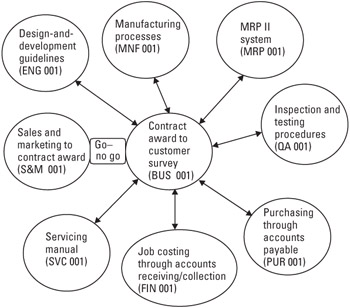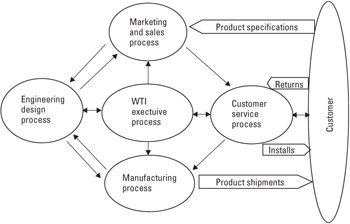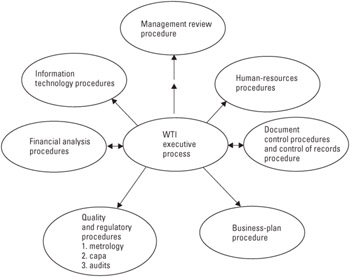Chapter 6: Process Document Design
|
6.1 The Process Document
The tier II document is expressed in many different ways, all of which are identical. For example:
-
SOP;
-
Process document;
-
Hub document;
-
Quality-assurance procedure;
-
Quality or control plan.
The role that the process document plays in the QMS is to describe the time-dependent behavior of the system after it has been defined in terms of quality policy statements. The importance of the process document cannot be overly emphasized. It is actually the first document that should be drafted prior to any other, including the quality manual (or alternately, the quality policy manual or quality system manual).
6.1.1 The Critical Development of Processes
Because the identification of processes, their sequencing and interaction, and a description of such interactions is the most dramatic revision to the 1994 version, it requires that we carefully analyze the way in that this critical requirement can be responded to effectively.
Let us consider a typical manufacturing company and what its total marketing and sales to after-sales service process could look like as our identification of processes [refer to Par. 4.1(a) of the Standard]. This concept is shown in Table 6.1. The process is described in tabular form although we could have used a flow chart graphic.
| 4.1 Requirements Apogee has chosen to define its operational processes in terms of core competencies that represent the various phases of the business cycle. The business process is summarized in the following table. | |||||||
|---|---|---|---|---|---|---|---|
| Core Phase | Core Activity | Managed by... | Inputs | Outputs | Resources/Controls | Links to Document | |
| 1.0 | Board of directors | Chairman of the board | Investors Quarterly operations reports | Annual report Approved Budgets and Corporate Business Plan | Stock Approved budgets | Annual Apogee budget and business plan | |
| 2.0 | Executive office | President and chief executive officer Chief financial officer Chief information officer Human resources QA&RA | Annual Apogee corporate budget and business plan Department monthly reports | Corporate and departmental objectives and goals and budgets | Stock plan Budgets Objectives Management review | Departmental budgets and business plans (with objectives and metrics) Employee handbook | |
| 3.0 | Marketing and sales | Vice president (VP) of marketing and sales | Marketing and sales budgets and business plans Customer complaint status | Sales forecast Profit and loss (P&L) Distributors Representatives New product requirements Return material authorizations (RMAs) | Sales force Budgets/objectives Advertising Brochures Price lists | Marketing and sales process document Product brochures Customer service process document | |
| 4.0 | Research, development, technology, and engineering (RDT&E) | VP of RDT&E | RDT&E budgets and business plans New product requirements | Prototypes Product specification Regulatory compliance Test equipment Documentation | Engineering staff Budgets/objectives Capital equipment Project plans | RDT&E process document Engineering standards manual | |
| 5.0 | Operations | VP of operations | Operations budgets and business plans Production transfer package | Manufactured products Private labels Warehousing Facilities management Outsource management RMA repairs | Operations staff Budgets/objectives Yield and scrap analysis Preventive maintenance | Operations process document Device history records | |
| 6.0 | Customer service | Customer-service manager | Customer-service budgets and business plans RMAs Product specifications | Spare parts and repairs P&L Repairs Installations Customer-complaint management | Customer-service staff Budgets/objectives Field service personnel Repair facilities | Customer-service process document Customer-service brochures and price lists | |
|
[*]The business process chart defines responsibility for each core competency of the operation and references the appropriate next tier documentation required to implement an effective quality management system. | |||||||
We have chosen to show the business process discussion as part of the manual because a description of the interaction between the processes is required to be within the manual. The illustration includes the formatting technique used to create this integrated text and graphics approach. The manual has been formatted to exactly match the Standard's nomenclature so the text begins with 4.1: Requirements—Apogee has chosen to define its operational processes in terms of….As demonstrated, the integrated example covers the requirements found in Par. 4.1(a), 4.1(b), and 4.2.2(c) of the Standard.
Business/quality objectives are used to measure progress at the corporate and departmental levels. The sequence and interaction of the processes are identified in terms of the input and output activities in that the output of one phase becomes the input to the next phase. In this manner, the manual describes the interaction between the processes of the QMS as required by Par. 4.2.2(c) of the Standard.
The process document is the "homework" part of the QMS design. It is the research mechanism that establishes whether we really understand the organization's dynamics. It is the document, as incomplete as it might be, that models the organization's ability to manage change and continuous/continual improvement. There is no specific way to write the document, and we will demonstrate two methods that can be used to compose the initial draft (i.e., a process table approach and a cyclic flow chart approach.
In the first exercise, the Steward for Element 7.5.1: Control of Production and Service Provision has brought her team together and created a department-to-department process document that carefully maps the interfaces or "hand-offs" from one department to another. The results are shown in Table 6.2.
| Stages | Description | Activities and Hub Documentation |
|---|---|---|
| 1 | Marketing and sales (M&S) procurement process | The vice president of M&S manages the procurement of contracts via the quoting process and manages the use of advertising and brochures to increase market share. S&M 001. |
| 2 | Design and development process | The vice president of engineering manages the design and development of new and modified products as required through the procurement process. Manufacturing release packages are prepared by the engineering department. Eng 001. |
| 3 | M&S purchase order review process | The vice president of M&S supports the manufacturing process via the management of customer purchase orders. Sales and marketing supplies the release package to production control. S&M 002. |
| 4 | The build plan | The vice president of manufacturing prepares the build schedules and review with purchasing. MNF 001, Stage One. |
| 5 | Purchasing | The purchasing manager negotiates and procures material required to meet kit schedules. PUR 001, Stage One. |
| 6 | Receipt of raw material | The receiving and shipping department verify and receive raw material, and quality assurance runs acceptance testing. MNF 001, Stage 2; and QA 002. |
| 7 | Stocking raw material | Production control stocks, releases, and inventories raw material. MNF 001, Stage 3. |
| 8 | Kitting | The materials department kits raw material and transfers the kits to production control. MNF 001, Stage 4. |
| 9 | Assembly and test | Production assembles and tests boards and integrates box level product. MNF 001, Stage 4; and WI series 1-001 through 1-087. |
| 10 | Shipment to customer | The shipping department verifies customer order/pick ticket, final configuration and testing, and packaging and shipping documentation, and delivers product to customer. MNF 001, Stage 5; and W/I series 2-001 through 2-016. |
| 11 | Customer service | The customer-service manager manages the return of products, their repair, and the analysis of nonconformities in conjunction with the quality-assurance manager. |
In the second exercise, the Steward for Element 5.0: Management Responsibility has brought the executive group together and created a cyclic flow chart to diagram the entire development process. The results are shown in Figure 6.1.

Figure 6.1: Excellent's total business processes.
6.1.2 Process Document Application
Another application of the recommended process document in QMS structures is illustrated in Figure 6.2. In this figure, each circle directly attached to the executive process represents a process document, including the executive process itself.

Figure 6.2: Wolf Telecommunications, Inc.'s (WTI) business process.
Figure 6.3 indicates how the executive process document sends the reader to specific tier III procedural documents. The same type of structure can be generated for each of the process documents illustrated in Figure 6.2.

Figure 6.3: Wolf Telecommunications, Inc.'s (WTI) executive process with associated procedures.
For example, the marketing and sales process document would send the reader to such procedures as marketing guidelines, program management guidelines, OEM sales guidelines, distributor agreements, and order entry.
The engineering design process to hardware design guidelines, software design guidelines, engineering document control, engineering standards, and design transfers to manufacturing. The manufacturing process document to inspection and testing, preventive maintenance, facilities, purchasing, control plans, control of nonconforming material and product, ESD control, and packaging. The customer service process document to installation guidelines, returned goods, and field service contract agreements.
In this manner, there is a clearly established link between the quality manual prescriptive quality policy statements, the organization's core competencies expressed as process documents, and the procedural documentation.
|
EAN: 2147483647
Pages: 155